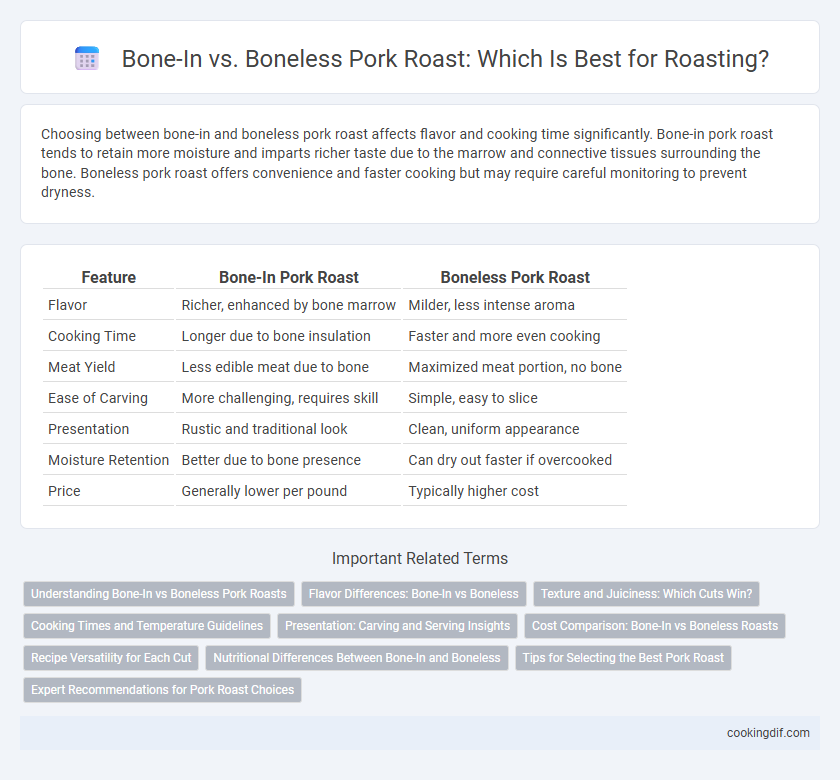Choosing between bone-in and boneless pork roast affects flavor and cooking time significantly. Bone-in pork roast tends to retain more moisture and imparts richer taste due to the marrow and connective tissues surrounding the bone. Boneless pork roast offers convenience and faster cooking but may require careful monitoring to prevent dryness.
Table of Comparison
| Feature | Bone-In Pork Roast | Boneless Pork Roast |
|---|---|---|
| Flavor | Richer, enhanced by bone marrow | Milder, less intense aroma |
| Cooking Time | Longer due to bone insulation | Faster and more even cooking |
| Meat Yield | Less edible meat due to bone | Maximized meat portion, no bone |
| Ease of Carving | More challenging, requires skill | Simple, easy to slice |
| Presentation | Rustic and traditional look | Clean, uniform appearance |
| Moisture Retention | Better due to bone presence | Can dry out faster if overcooked |
| Price | Generally lower per pound | Typically higher cost |
Understanding Bone-In vs Boneless Pork Roasts
Bone-in pork roasts retain moisture and flavor due to the marrow and connective tissues simmering during cooking, enhancing tenderness and taste. Boneless pork roasts offer easier carving and uniform cooking times, making them ideal for quick meals and consistent slices. Choosing between bone-in and boneless depends on desired flavor intensity, cooking method, and presentation preferences.
Flavor Differences: Bone-In vs Boneless
Bone-in pork roasts deliver enhanced flavor due to marrow and connective tissues that break down during cooking, enriching the meat with depth and juiciness. The bone acts as a heat conductor, promoting even cooking and retaining moisture, which results in a more succulent and flavorful roast. In contrast, boneless pork roasts offer convenience and uniform slices but typically lack the intensified taste and moisture retention that bones provide.
Texture and Juiciness: Which Cuts Win?
Bone-in pork roasts retain more moisture during cooking, delivering a juicier and more flavorful texture due to the marrow and connective tissues imparting richness throughout the meat. Boneless cuts offer ease of carving and consistency but tend to lose moisture faster, resulting in a drier, less tender bite if not carefully monitored. Choosing bone-in cuts like pork shoulder or ribs ensures optimal juiciness and a robust, tender texture, making them superior for slow roasting methods.
Cooking Times and Temperature Guidelines
Bone-in pork roasts generally require longer cooking times due to the heat conduction properties of the bone, typically roasting at 325degF for 20-25 minutes per pound to reach an internal temperature of 145degF. Boneless pork roasts cook faster, often needing 15-20 minutes per pound at the same temperature, allowing for quicker heat penetration throughout the meat. Maintaining proper internal temperature guidelines ensures tenderness and food safety regardless of bone presence.
Presentation: Carving and Serving Insights
Bone-in pork roast offers a striking presentation with the bone serving as a natural centerpiece, enhancing visual appeal when carved. The bone also provides a sturdy guide for slicing consistent, uniform portions. Boneless pork roast streamlines carving with easy, clean cuts, making serving quicker and more convenient for guests.
Cost Comparison: Bone-In vs Boneless Roasts
Bone-in pork roasts typically cost less per pound compared to boneless roasts due to the weight of the bone, which is not edible but adds to the overall weight. Boneless pork roasts command a higher price because they require additional butchering and offer easier slicing and serving convenience. Consumers seeking cost efficiency often opt for bone-in roasts despite the presence of the bone, while those prioritizing ease of preparation may prefer boneless cuts despite the premium price.
Recipe Versatility for Each Cut
Bone-in pork roast offers enhanced flavor and moisture retention, making it ideal for slow roasting and braising recipes that benefit from rich, succulent meat. Boneless pork roast provides greater ease and speed in cooking, perfect for roasting, slicing, and recipes requiring uniform thickness or stuffing. Each cut's versatility directly impacts texture and presentation, allowing cooks to tailor dishes from traditional Sunday roasts to innovative stuffed pork entrees.
Nutritional Differences Between Bone-In and Boneless
Bone-in pork roast typically retains more moisture and flavor due to the marrow and connective tissues surrounding the bone, which can enhance the overall nutrient profile by preserving essential fats and minerals. Boneless pork roast offers a leaner option with reduced fat content, making it lower in calories but sometimes less rich in certain nutrients like collagen and calcium. Choosing between bone-in and boneless depends on nutritional goals, balancing between richer flavor and mineral content versus leaner protein intake.
Tips for Selecting the Best Pork Roast
Choose a bone-in pork roast for enhanced flavor and moisture retention during cooking, as the bone helps distribute heat evenly. Opt for a boneless pork roast when you prefer easier carving and quicker cooking times, ensuring it has a uniform size and firm texture. Select fresh pork with a pinkish-red color, minimal marbling, and a firm, springy feel to guarantee tenderness and juiciness in your roast.
Expert Recommendations for Pork Roast Choices
Experts recommend bone-in pork roasts for juicier, more flavorful results due to the marrow and collagen imparting moisture during cooking, which enhances tenderness and richness. Boneless pork roasts are favored for easier carving and quicker cooking times, making them ideal for convenient meal preparation without sacrificing texture. Professional chefs advise selecting bone-in cuts like pork shoulder or rib roast for slow roasting, while boneless loin or sirloin roasts suit faster, high-heat methods.
Bone-In vs Boneless for Pork Roast Infographic

 cookingdif.com
cookingdif.com